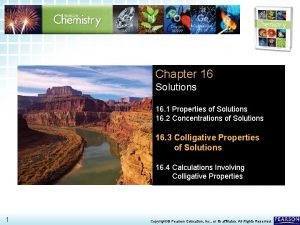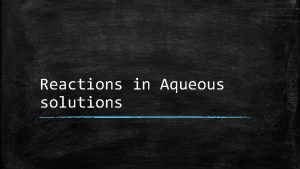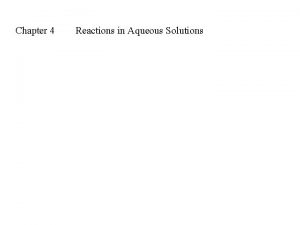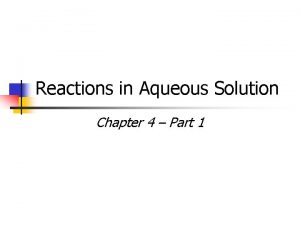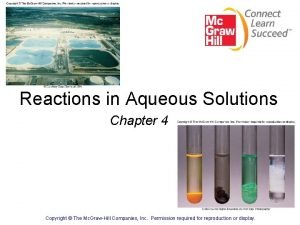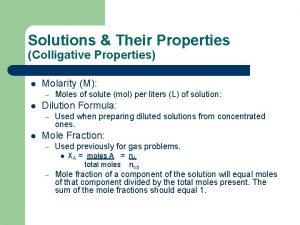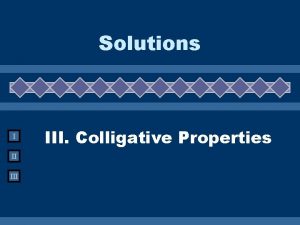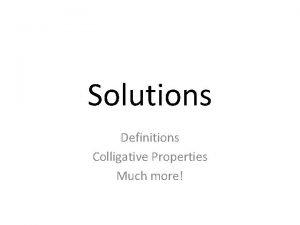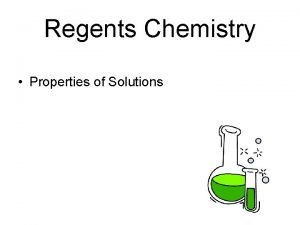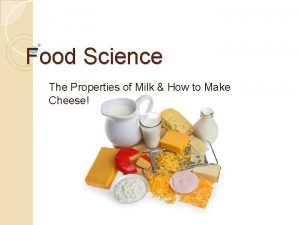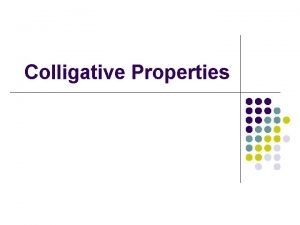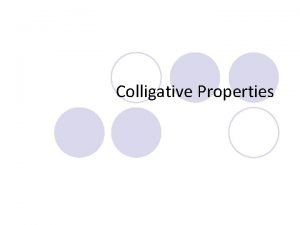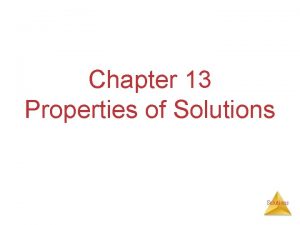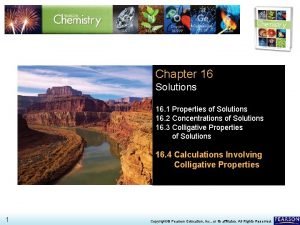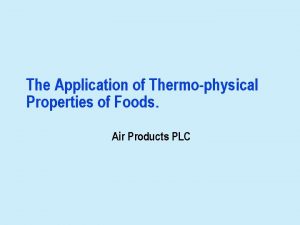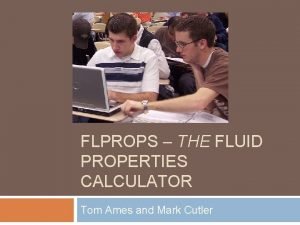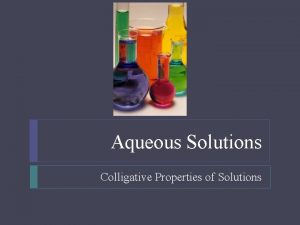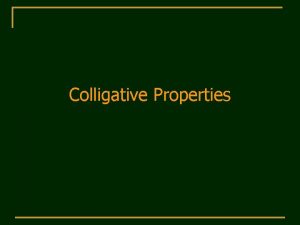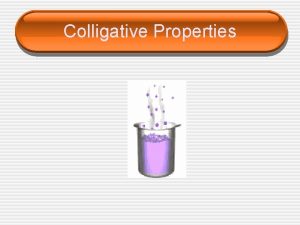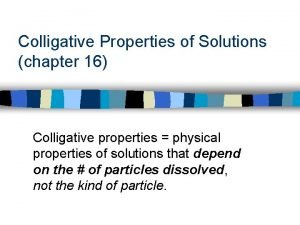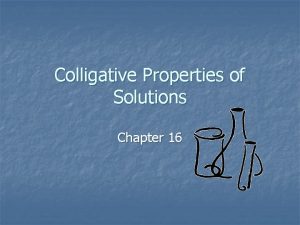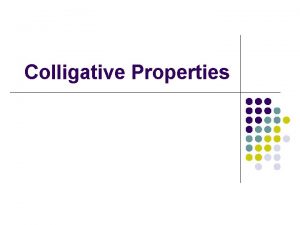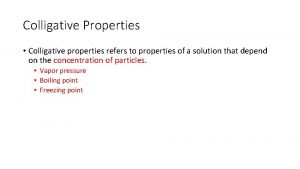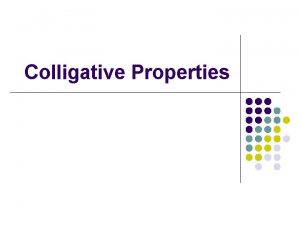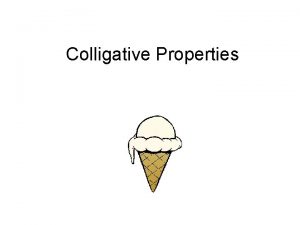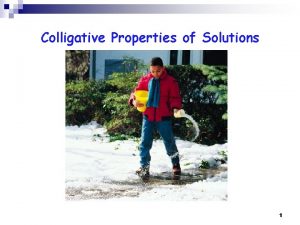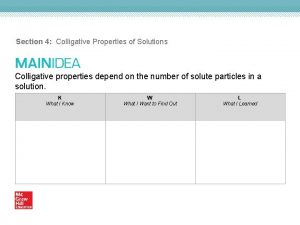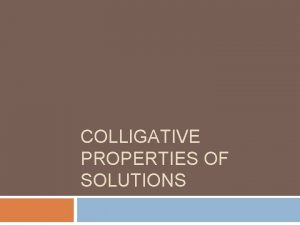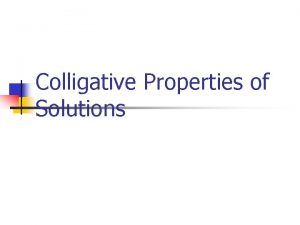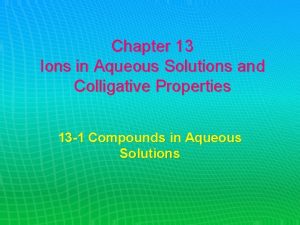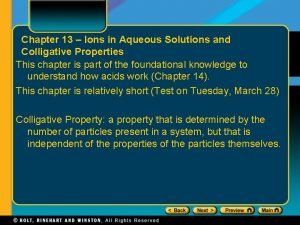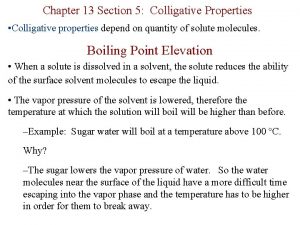Ions in Aqueous Solutions and Colligative Properties Chapter
























- Slides: 24

Ions in Aqueous Solutions and Colligative Properties Chapter 13 Chemistry

Compounds in Aqueous Solutions 13 -1

13 -1 Learning Targets l Write complete ionic and net ionic equations for chemical reactions in aqueous solutions l Use solubility rules to predict precipitates

Dissociation l The separation of ions that occurs when an ionic compound dissolves l Na. Cl (s)→ Na+ (aq) + Cl- (aq) l One formula unit of Na. Cl produces two ions l One mole of Na. Cl produce two moles ions

l Write the equation for the dissolution of magnesium chlorate in water. How many moles of ions are produced for every 1 mol of magnesium chlorate dissolved? l Mg(Cl. O 3)2 (s)→ Mg 2+ (aq) + 2 Cl. O 3 - (aq) l 3 mol

How many moles of ions? l KI→K+ + Il 2 mol l Na. NO 3→ Na+ + NO 3 – l 2 mol l Na 2 SO 4→ 2 Na+ + SO 4 2– l 3 mol

“Driving Forces” of reaction l What “pulls” reactants to products l 1 - formation of solid (precipitate) l 2 - formation of water l 3 - transfer of electrons l 4 - formation of gas


Precipitation Reaction l Solid formed during reaction l Type of double displacement reaction l Precipitate- solid that forms from solution l Precipitation –process of precipitate forming l Use rules when solution are mixed and partners are traded to determine if the products are insoluble (precipitate)

Solubility Rules l Soluble- dissolves in water l Slightly soluble- insoluble in water, only a few ions form l No compound is completely insoluble l Dissociation equation cannot be written for insoluble compounds

l Dissociation equation for soluble substance l Na 2 SO 4 (s)→ 2 Na+ (aq) + SO 42 - (aq)

l 7 - Most hydroxide compounds are only slightly soluble (insoluble). Exceptions: Na. OH and KOH

Are these soluble? l KCl l Soluble l Fe. S l Insoluble l Ag. Cl l Insoluble l Ca. S l soluble l Cd. S l Insoluble l NH 4 Br l Soluble l Na. SO 4 l soluble l Ba. SO 4 l insoluble

l Review ions and polyatomic ions l Will make writing equations easier and faster

Molecular Equation (formula) l Shows complete reactant and products l K 2 Cr. O 4 (aq) + Ba(NO 3)2 (aq) → 2 KNO 3(aq) + Ba. Cr. O 4 (s) (yellow ppt)

Complete Ionic l All are represented as ions l 2 K+ (aq)+ Cr. O 42 - (aq) + Ba 2+(aq)+ 2 NO 3 (aq) → 2 K + (aq) + 2 NO 3 - (aq)+ Ba. Cr. O 4 (s)

Net Ionic l Includes only those ions directly involved in the reaction (what will form the precipitate (ppt)) l No spectator ions present l Spectator ions- do not take part in chemical rxn ¡Found in solution before and after rxn l Cr. O 4 2 - (aq) + Ba 2+(aq) → Ba. Cr. O 4 (s)

l Molecular l K 2 Cr. O 4 (aq) + Ba(NO 3)2 (aq) → 2 KNO 3(aq) + Ba. Cr. O 4 (s) (yellow ppt) l Complete ionic l 2 K+ (aq) + Cr. O 42 - (aq) + Ba 2+(aq) + 2 NO 3(aq) → l 2 K + (aq) + 2 NO 3 - (aq)+ Ba. Cr. O 4 (s) l Net ionic l Cr. O 4 2 - (aq) + Ba 2+(aq) → Ba. Cr. O 4 (s)

Ionization l Ions are formed from solute molecules by the action of the solvent l Polar water molecules attracted to polar solute molecules l Electronegative O of water attracted to electropositive portion of solute molecule l Electropositive H of water attracted to electronegative portion of solute molecule

l HCl → H+ (aq) + Cl- (aq) l Polar water can break HCl bonds forming ions l Extent solute ionizes depends on strength of bonds within molecules of solute and strength of attraction between solute and solvent l Strong acids and bases ionize completly

Hydronium Ion l H 3 O+ ion= hydronium ion l Typically get with strong acid in water l Proton transferred from acid to water molecule l H 2 O (l) + HCl (g) → H 3 O+ (aq)+ Cl- (aq)

Electrolyte l Provides ions in water solution = a better conductor l Strong electrolyte- Any compound of which all or almost all dissolved compound exists as ions in aq solution l All ionic compounds l Hydrogen halide (HCl, HBr, HI)

l Weak Electrolytes l A compound of which a relatively small amount of the dissolved compound exists as ion in aq solution ¡HF, organic acids

Which solution contains larger total concentration of ions? l 0. 20 M HCl or 0. 01 M HCl l 0. 20 M higher concentration l 0. 5 M HCl or 0. 5 MHF l HCl, stronger acid
 Ions in aqueous solutions and colligative properties
Ions in aqueous solutions and colligative properties Chapter 13 ions in aqueous solutions
Chapter 13 ions in aqueous solutions Colligative properties
Colligative properties General properties of aqueous solutions
General properties of aqueous solutions Positive ions and negative ions table
Positive ions and negative ions table Chapter 4 reactions in aqueous solutions
Chapter 4 reactions in aqueous solutions Concentrated solution
Concentrated solution Chapter 4 reactions in aqueous solutions worksheet answers
Chapter 4 reactions in aqueous solutions worksheet answers Chapter 4 reactions in aqueous solutions
Chapter 4 reactions in aqueous solutions Is molarity a colligative property
Is molarity a colligative property Pourcentage massique
Pourcentage massique Dot
Dot Colligative property definition
Colligative property definition Colligative property definition
Colligative property definition Regents chemistry solutions practice problems
Regents chemistry solutions practice problems Colligative properties of milk
Colligative properties of milk Applications of colligative properties
Applications of colligative properties Colligative properties worksheet
Colligative properties worksheet Vant hoff factor of glucose
Vant hoff factor of glucose Pure solvent
Pure solvent Colligative properties depend on the _____.
Colligative properties depend on the _____. Colligative properties depend on
Colligative properties depend on Colligative properties sample problems
Colligative properties sample problems Costherm
Costherm Fluid property calculator
Fluid property calculator


